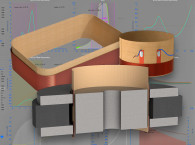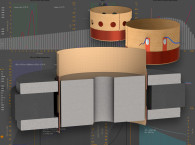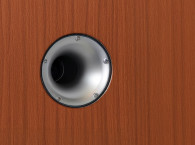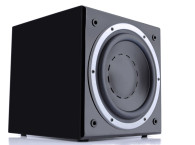
High Displacement Acoustic Transducer Systems
Patent Application Publication Number: 2016/0157035
Inventors: David Russell; (Toronto, CA); John French; (Caledon, East, CA)
Assignee: Audera Acoustics, Inc. (Schomberg CA)
Filed: November 27, 2015
Current CPC Class: H04R 7/16
Published: June 2, 2016
Number of Claims: 25
Number of Drawings: 8
Abstract from Patent
Acoustic transducer systems are described herein and in particular, acoustic transducer systems involving high displacement are described. An example acoustic transducer system includes an acoustic driver, a diaphragm position sensing module for generating a position signal corresponding to a displacement of a diaphragm of the acoustic driver, and a controller operable to: receive an input audio signal; generate a control signal based at least on the input audio signal and the position signal; and transmit the control signal to a voice coil operably coupled to the diaphragm so that the voice coil moves within an air gap within the acoustic driver at least partially in response to the control signal. A height of the voice coil can correspond substantially to a gap height in some embodiments.
Independent Claims
1. An acoustic transducer system comprising: a driver motor operable to generate a magnetic flux; a diaphragm operably coupled to the driver motor; a voice coil coupled to the diaphragm, the voice coil being movable at least in response to the magnetic flux; a diaphragm position sensing module generating a position signal corresponding to a displacement of the diaphragm relative to an initial position of the diaphragm; and a controller in electronic communication with the driver motor and the diaphragm position sensing module, the controller being operable to: receive an input audio signal; generate a control signal based at least on a version of the input audio signal and the position signal; and transmit the control signal to the voice coil, the voice coil moving at least in response to the control signal.

Reviewer Comments
One of the two inventors on this patent is John B. French, inventor of the unique, high-efficiency bridge-mode signal tracking power amplifiers (BASH) from the 1990s sold under the Blade Technologies brand, from Canada, and since 2004, French has been the CTO of Audera, also of Canada, carrying forward modernized versions of his original works.
The invention provides a magnet structure for a loudspeaker having an annular magnetic gap for mounting and centering the voice coil within the annular gap while allowing for linear movement of the coil in the gap. The voice coil has a length substantially the same as the thickness of the top plate, without underhand or overhang.
Further included is a voice coil position sensing module generating a position signal corresponding to a displacement of the voice coil, the displacement being a position of the voice coil relative to an initial stasis position. Also, there is a controller in electronic communication with the driver motor and the voice coil position sensing module, the controller being operable to: receive an input audio signal; generate a control signal based on the input audio signal and the position signal; and transmit the control signal to the voice coil, the voice coil moving in response to the control signal.
The invention’s core motor structure is similar to the high output systems developed by Clifford Blodget of Ultra Research, Inc., in Texas, in the mid-1990s. In particular the “Ultra Structure Subwoofer” as disclosed in international application, WO9854924. The Blodget structure also incorporated a voice coil length equal to the gap length. In the Blodget design, the top plate was at least 50% greater thickness than it would be if it were operated at the point of magnetic saturation, as with conventional top plates.

The Blodget design also had a center pole piece that extended beyond each end of the voice coil and top plate. This provided intimate coupling with the voice coil at all excursion displacements such that the center pole piece provided an effective heatsink at all excursion levels.
In the Blodget and the currently reviewed patent application, the voice coil does not have any overhang and therefore, has better thermal coupling and less voice coil heating at the end portions, as compared to normally overhung systems.
At first impression, one might think that having a non-overhung or underhung voice coil would be quite nonlinear, but with these systems the flux density along the gap is somewhat lower than normal and the fringe flux beyond the gap can continue to be a significant portion of the flux level within the gap such that the motor maintains greater linearity than expected. Because of this, the Blodget woofer system was quite impressive in being able to maintain good sound quality at excursions on the order of 2” peak-to-peak while exhibiting excellent thermal capability.
The Russell/French system is based on the Blodget architecture, but brings the addition of a sophisticated position sensor and feed forward or feedback correction system to further linearize the driving force over the full peak-to-peak mechanical excursion capability of the structure (as long as there is some portion of the voice coil remaining in the gap).
The patent discusses a variety of known sensor and corrective electronics to complement the woofer transducer and many of the disclosed motional and thermal compensation systems should be quite effective. Having been impressed by measuring and experiencing the significant capability of the simple and elegant Blodget system nearly two decades ago, I would very much expect the new Russell/French version, with the addition of electronic motional correction systems, to achieve state-of-the-art performance. VC
This article was originally published in Voice Coil, October 2016.






